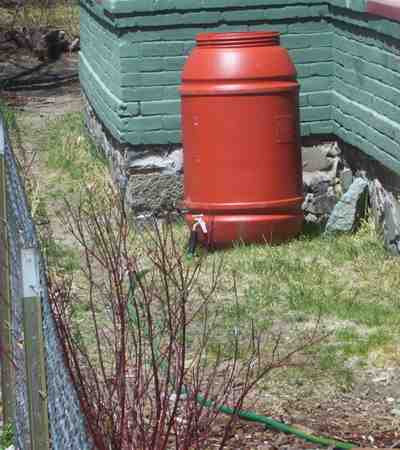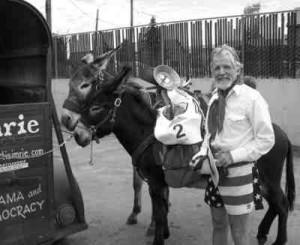Article by Dan Fitzgerald
Water – May 2008 – Colorado Central Magazine
IT’S BEEN WEEKS since a drop of rain has fallen in Tucson, but Brad Lancaster’s backyard vegetable gardens and fruit trees are thriving. By collecting and storing the rain that falls on his property, Brad harvests about 45,000 gallons annually from his modest home and 1/8 acre lot. As Brad shows me his pomegranate, olive, orange, and white sapote (a banana-like fruit) trees, it’s easy to forget that Arizona, like much of the West, is a desert.
If you tried to create such a sustainable oasis in Colorado, however, you’d be breaking the law and subject to fines up to $500 per day. That’s because other water users in Colorado already have rights to the rain before it lands in your rain barrel. How could that happen?
Like other western states, Colorado water law follows the prior appropriation doctrine, of which the core principle is “first in time, first in right.” The first person to put water to beneficial use and comply with other legal requirements obtains a water right superior to all later claims to that water. These water rights are known as appropriations.
The right to appropriate is enshrined in Colorado’s Constitution and has been so scrupulously honored that nearly all of the rivers and streams in Colorado are over-appropriated, which means there is often not enough water to satisfy all the claims to it. When there isn’t enough water for all of the legitimate users, typically in the summer months, senior water right holders can “call the river” and cut off the flow to those who filed for water rights later, so-called “juniors.”
Over-appropriated rivers are not unique to Colorado. Most of the watercourses in the West are fully or over-appropriated. Yet other Western states allow or even encourage rainwater harvesting. It’s legal in New Mexico, where Albuquerque recently passed building standards requiring catchment systems for new houses.
The obstacle for aspiring rainwater harvesters in Colorado is not the state Constitution. There is nothing in the Constitution that allows appropriators of rivers and streams to claim the rain above your head. In fact, Colorado’s Constitution speaks only of the right to divert the “unappropriated waters of any natural stream.”
The problem arises because Colorado’s Supreme Court has given an expansive interpretation to the term “natural stream” and coupled that with a presumption that any diffused waters will ultimately migrate to groundwater or surface stream flows. While other states would view rain as diffused surface waters that a landowner would be entitled to impound and use at will, Colorado presumes, without real evidence, that all rain is tributary to a stream. And since most streams are over-appropriated, collecting rainwater is seen as diverting the water of those who already hold rights to it.
KRIS HOLSTROM has encountered the harsh reality of Colorado’s legal fiction. A regional sustainability coördinator, she lives with her husband and two children in a solar-powered home in San Miguel County, 16 miles from Telluride. With the help of a few interns she grows organic produce year-round, most of which is sold to local restaurants and farmers markets. On a mesa at 9,000 feet elevation, water other than precipitation is hard to come by.

So Kris did what thousands of farmers before her have done; she applied for a water right. Except instead of seeking to divert water from a watercourse, she sought to collect the rain as it ran from the roof of her house and greenhouse. To her surprise, the State Engineer opposed her application, arguing that her roofs were “tributary” to the San Miguel River. And since the San Miguel River is “on call” during the summer months, Holstrom’s rain catchment would, the State Engineer argued, “cause injury to senior water rights.” The Water Court agreed, and Kris Holstrom was denied the right to store a few barrels of rainwater.
Kris remembers her dismay at the outcome. “The San Miguel River is over three miles from our property. There was no proof offered to the court that the water dripping from my roof would ever make it to the river. If it’s true that someone else owns the rain, shouldn’t they pay for a roof to keep their rain off my stuff?”
That wasn’t going to happen. And while it didn’t appear the State Engineer’s office was going to bust people with catchment systems, the State was not going to allow permits to be granted for rain barrels. If Kris wanted to collect rainwater for her organic gardens, she’d have to do it illegally. The only legal option for her, as the State Engineer told the Water Court, was to pursue an augmentation plan.
An augmentation plan is a way for junior appropriators to divert water from fully appropriated sources. Conditions are placed on the juniors to protect senior water rights from the depletions caused by the new diversions. The burden would be on Kris to convince the State Engineer and Water Court that she had a detailed plan in place to replace to the stream 100% of the precipitation she captured. Not only did she have to return every drop of rain she collected to the stream, she would have to pay for a complex engineering analysis to prove that her augmentation water would return to the stream in a timeframe that mimicked natural conditions.
SHE DIDN’T EVEN TRY. “The farm doesn’t make enough money to pay for an engineering analysis.” More importantly, there was no other source of water that didn’t already belong to someone else. “If I had another source of water, I would have used that in the first place. We tried hauling water to the farm, but it just wasn’t economically feasible, even on our small scale.”
Indeed, it’s difficult to imagine a situation where it would make economic sense to harvest free rainwater that has to be replaced with some other source of water. Requiring augmentation plans for domestic use rainwater harvesting comes eerily close to fulfilling Thomas Merton’s prophesy: “someday they will even try to sell you the rain.”
The notion that you can’t utilize the rain falling on your roof might be easier to accept if you really were interfering with senior water rights, but in most situations that just isn’t true. In Kris’s case, most of the rain she collected for her gardens would have otherwise evaporated or been transpired by native vegetation long before it ever reached the San Miguel River.
A recent study commissioned by Douglas County and the Colorado Water Conservation Board has confirmed that very little precipitation that falls on an undeveloped site ever returns to the stream system through groundwater and surface water. The study focused on an area in northwest Douglas County, where the average annual yield from precipitation is 17.5 inches. In dry years, 100% of the annual precipitation is lost to evaporation and transpiration by vegetation (evapotranspiration). In wet years, a maximum of 15% of the precipitation returns to the stream system. On average, just 3% of annual precipitation ever returns to the stream.
Despite this hydrological reality, Colorado law requires anyone wanting to use rainwater catchment to send to the stream an amount of water equivalent to 100% of all precipitation harvested — in effect, a gift to prior appropriators paid for by folks trying to live more sustainably.
DENYING LANDOWNERS the right to collect rainwater that never would have made it to the stream seems to violate other aspects of Colorado law. Returning to Kris Holstrom’s mesa-top farm illustrates the point. The Court relied on the legal fiction that presumes all rain is tributary to the stream to deny Kris a permit for her small catchment system. The legal fiction is inconsistent with hydrological reality. But more importantly, if the rain in fact doesn’t make it to the stream, senior appropriators down on the San Miguel River have not previously diverted or put to beneficial use the rain Kris sought to collect from her roof.
A diversion and actual application to beneficial use are fundamental requirements for obtaining water rights under prior appropriation law. Since the seniors had not previously diverted or used the rain that falls on Kris’s roof, they could not possibly have obtained a valid right to it. And since the seniors could not have had a valid right to rain falling on Kris’s roof, the Water Court should not have accepted the State Engineer’s argument that Kris’s rain barrels would violate the rights of seniors down on the San Miguel.
A faltering effort to address this problem has come before the Colorado Legislature. Denver Senator Chris Romer introduced a bill that would allow rural residents who aren’t on a municipal water system to store rainwater in cisterns up to 5,000 gallons. But the bill states that users of such cisterns may still be required to replace the rain they collect. So folks like Kris Holstrom could still be shut down by the State Engineer, and the earlier appropriators of streams still own the rain.
Romer’s bill also authorizes ten pilot projects statewide where new housing developments may collect rainwater from rooftops and other impermeable surfaces. While the bill pays lip service to water conservation, promoting real estate development in areas facing water supply challenges may be it’s primary goal. Rain collection is still prohibited for all existing homes served by a municipal water system. And there is nothing in the legislation to prevent the potential benefits of rainwater harvesting from being dissipated into oversized yards filled with water guzzling bluegrass. A serious effort at conservation would limit the outdoor use of harvested rainwater to food production and xeriscaped yards. It’s time to heed Wallace Stegner’s advice: “You have to get over the color green; you have to quit associating beauty with gardens and lawns.”
EVEN GREATER BENEFITS could be achieved by promoting wide-scale rainwater harvesting in developed areas. Traditional land development practices typically direct runoff from roofs and other impervious surfaces to pollutant-laden streets and parking lots, and then toward storm drains. A clean water source is almost instantly transformed into a burden on stormwater systems and a pollution problem for downstream users. Both of these problems would be ameliorated if all buildings were equipped to catch rainwater for later use. Additional benefits could be realized if the water collected from rooftops was brought inside for non-potable uses. Rainwater that otherwise would be lost to evaporation or storm drains could be used in toilets and washing machines and then sent to the treatment plant, thereby bringing more water into municipal water systems. At the same time, millions of gallons of potable water will not have been wasted on needs that are satisfied with untreated water.
Colorado should be taking a more aggressive approach to water sustainability. Three million new residents are expected by 2035. At the same time, climate change will be conspiring to exacerbate the water woes of Colorado and the other states served by the Colorado River. A 2° C temperature increase alone will decrease mean Colorado River flows by 29%. Couple that with a 10% decrease in precipitation and the upper basin could suffer a 44% decline in streamflow. So just how bad is that? A mere 20% decrease in natural runoff translates into a 60-70% mean annual loss of storage, and a 60% reduction in power generation.
Rainwater harvesting is no panacea to deal with water shortages of this magnitude. But it should be part of a multi-faceted approach to deal with a looming crisis. Fully utilizing precipitation where it falls reduces the demand on other water resources, leaving more water in streams or aquifers. Changing the law to permit or require rainwater harvesting would result in millions of microstorage facilities in homes and buildings throughout the state, reducing evaporative losses and the pressure to build more large storage projects. It would also reduce the energy costs incurred in treating and distributing potable water. The Douglas County study noted that reducing peak summer water treatment demands could help utilities delay expansion of treatment and distribution facilities and lower peak electrical demands associated with pumping throughout distribution systems.
THE MOST IMPORTANT BENEFIT of a legal change stimulating wide-scale rainwater harvesting may be its fostering of a new water ethic. People who make a personal effort to collect and utilize rain are less likely to waste water or tolerate public policies that allow waste by others, such as inefficient irrigation techniques or inappropriate residential landscaping. When people are maintaining gutters and cisterns to ensure they can flush their toilets or grow their gardens, they are more likely to appreciate the importance and scarcity of the resource. They might finally say no to headlong growth that shows no regard for long-term availability of future water supplies.
Twenty years ago, Wallace Stegner accurately assessed the situation:
“What do you do about aridity, if you are a nation inured to plenty and impatient of restrictions and led westward by pillars of fire and cloud? You may deny it for a while. Then you must either adapt to it or try to engineer it out of existence.” The limits of trying to engineer a solution to aridity are now evident. Lake Powell and Lake Mead are only 45% and 50% full, respectively, and a recent study by scientists at the Scripps Institution of Oceanography concludes that both stand a 50% chance of running dry by 2021. Adaptation to nature’s limits is required.
Changing the law to permit rainwater harvesting is part of the adaptation Colorado should embrace. The legal fiction that all rain is tributary to a stream should be abandoned. Others should not be allowed to own the rain that falls on your roof before you can use it for reasonable domestic uses. As Brad Lancaster, the rainwater harvesting guru of Tucson says, “Reserving the right of catchment is one small safeguard for water democracy.”
Dan Fitzgerald is working on a Master of Laws in International Water Resources and lives in rainy Northwest Southeast Alaska.



